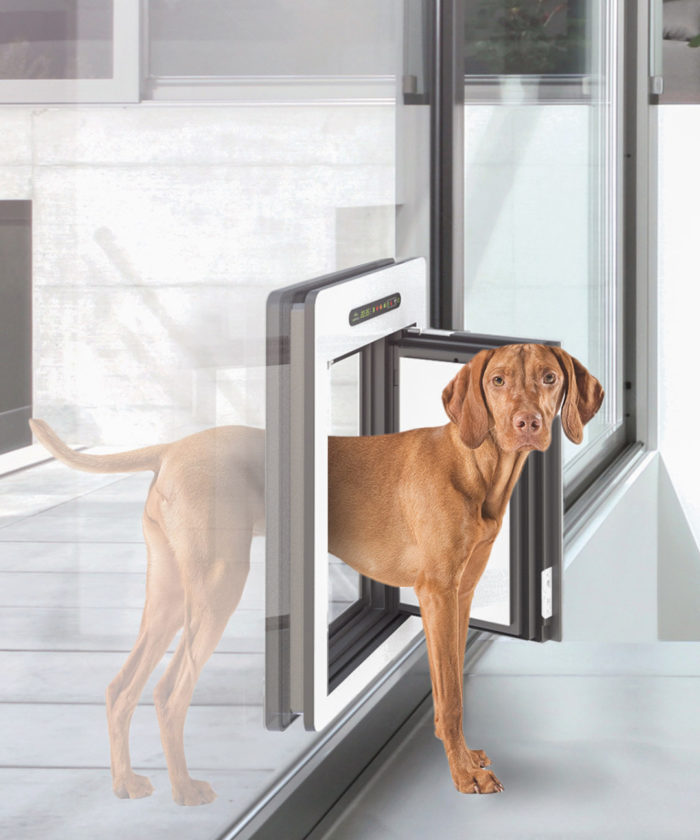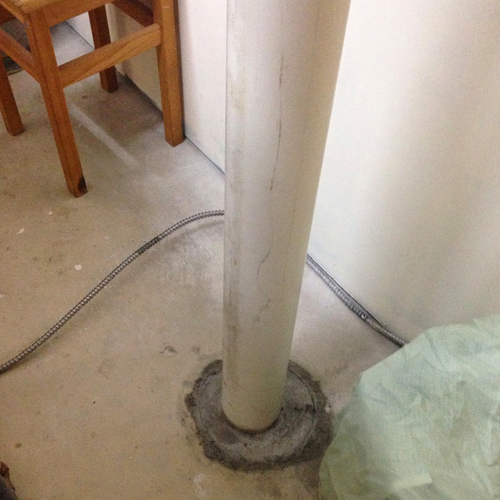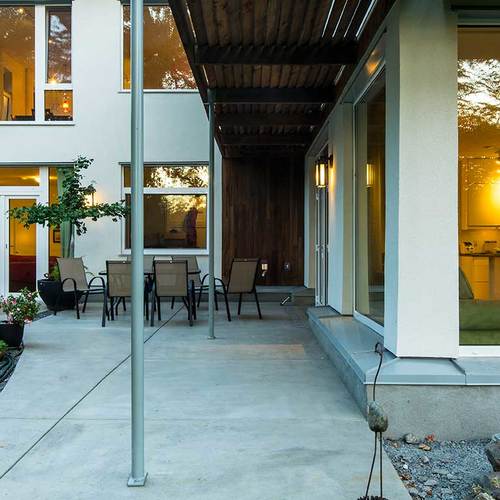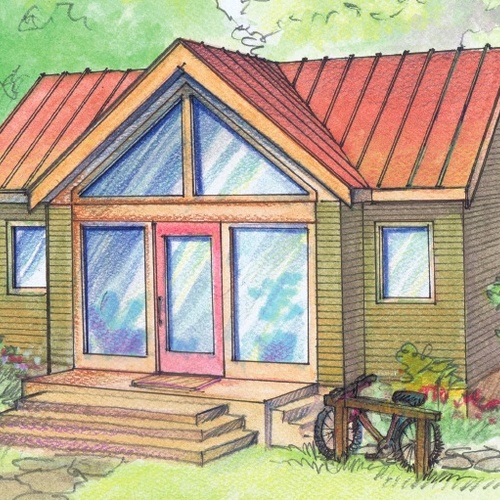
Image Credit: Image #1: PetWalk
Typical pet doors are verboten in a Passive House. Most pet door are convenient for a dog or cat, but are way too leaky to keep out the drafts.
Treehugger’s Lloyd Alter came across a solution at the 21st International Passivhaus Conference in Vienna and posted this report about the PetWalk, a vault-like, insulated door that won’t mess up a blower-door test and still lets the family pet come and go at will.
The PetWalk will open on command via a motion detector or a transponder implanted under the pet’s skin. It also can be activated with a remote control. The door comes with a backup battery so it can still work during a power outage.
The Austrian tech company that developed the door says pets catch on quickly. The door seals so tightly, Alter reports, there was no measurable air leakage at a pressure difference of 600 pascals. (A standard blower door test measures leakage at a pressure difference of 50 pascals). It’s available with thermal insulation of up to 0.5 w/m2k (equal to R-11).
There are two sizes, priced at $1,754 and $1,974.
Weekly Newsletter
Get building science and energy efficiency advice, plus special offers, in your inbox.















11 Comments
how common are pet doors in USA?
Off topic, but just find it curious that someone would make such a specific product, since I have never in my life seen a pet door in my area (central europe).
Is this standard, or still niche?
Response to Davor Radman
Davor,
The last time I checked, Austria was in Central Europe -- and that's where this pet door is manufactured.
My home has a pet door, and has for years.
According to an article posted on Bloomberg.com, "Americans now spend $41 billion a year on their pets — more than the gross domestic product of all but 64 countries in the world. That's double the amount shelled out on pets a decade ago, with annual spending expected to hit $52 billion in the next two years."
Yes, Martin, I am aware. I
Yes, Martin, I am aware. I live there. But I still have never seen it :)
An alternative
While these look quite spiffy, this alternative has been around for a while and has been rock solid in our house for over 6 years. Apparently certified to California standards for Title 24 and blower doors in Passive Houses.
https://energyefficientdogdoors.com/insulated-dog-doors
We thought ours had a tear about 3 years ago and contacted them, service was great and turned out it could be fixed with a screwdriver, no issues since.
I suppose transponders etc are nice, but how many people are going to climb through a door big enough to let them, wouldn't they wonder what size dog usually uses the door :) When we leave with the dog we lock it with a plywood panel that we DIY'd.
Not so common
Davor,
I agree, I haven't seen many of these in person. But I did install a pet door on one of my houses, and it was great. There were, however, some special circumstances. Specifically, we had a pedestrian door in the garage that entered into a fenced back yard. We installed a pet door to allow our dog to get out of the weather or away from bugs if he wished, but it only lead into an unconditioned garage, not into our house. I was concerned about security and didn't install a pet door at a second house, but in the right circumstances, they are great.
Aside: I thought that we might be moving in the near future, so I kept the original door and just bought a cheap metal one for installing the doggie door. When we put the house on the market, we just re-hung the original door.
Human-size version?
How nice this would be for the garage door, for the times when you arrive with arms full of groceries or are loading the car with luggage or camping gear.
Can one go to a locksmith to have an implanted transponder code changed?
Response to David McNeely
David,
Every supermarket in the country has an automatic door. I imagine that an intelligent tinkerer could figure out a way to control a supermarket-style door with a bracelet transponder.
We have a PetSafe dog door
We have a PetSafe dog door that unlocks upon detection of a collar mounted transponder. Our Shi-Tzu is mainly a house dog who goes out to the fenced yard to play and poop and the door gives him freedom to do so even when we're not home. The reason for the locking door is not to prevent mini-burglars from entering but to keep out any other critters that might be curious. I wouldn't want to find a raccoon or possum running around the house! While not certified for a passive home, with our mild climate in Florida I don't think that there is any detectable energy cost difference caused by the door. In fact, there would likely be far more AC loss from opening a human sized door every time the dog goes in or out than from the small double wall plastic flap being open for a few seconds even with whatever leakage there may be when it's closed. At a cost of less than $100 for the PetSafe unit vs. over $1700 for the one described it seems impossible to justify the additional cost.
Bruce
The urban racoons that live around my sister's house are savvy enough that they have learned to jimmy the lock on her transponder controlled cat door.
Passive Pet Doors
disclaimer: I work for Freedom Pet Pass (the company referenced earlier)
@Davor - Pet doors are pretty niche in general, even in the US. I had only seen one or two before I started working for a dog door manufacturer. That being said, I live in Michigan, and they're seemingly less common in colder climates. In the US and Australia, they're mostly for dogs in more rural areas. In western Europe, cat doors are much more common.
@James H - Thanks for the great feedback! We take a lot of pride in both our product's energy efficiency performance and our customer service. Glad to see you're still happy with your door.
Regarding the energy certifications, the Freedom Pet Pass door is the only one that I know of that has complied with the specific tests dictated by the California Energy Commission for Title 24. I don't have any reason to doubt that PetWalk could meet those standards if they had the appropriate tests conducted and documented, but they darned well better for $2,000.
Our doors have been incorporated into several Passive House builds. One of the more publicized ones is the Wayland, MA Passive House. There were several NESEA Pro Tours that went through that home. Our door was also included in the 16th & Nebraska house, documented in the book Recreating the American Home.
@Bruce - Your assumption is spot-on regarding impact of pet doors in mild climates, at least as far as we've found. Our virtually airtight door will only save 5s or 10s of dollars a year in cooling costs versus leaky doors (assuming relatively low winds). It can tough to justify a premium, efficient pet door based on energy savings alone in that situation.
In colder, windier areas, though, that number can be $30-$50 per winter with natural gas heat, and more with propane or fuel oil. That number, of course, depends on a variety of factors. There have been a handful of outlier cases (usually in a basement with a leaky house) where the stack effect causes air to constantly pour in virtually uninhibited through leaky dog doors. While those people also needed to seal up their house better, our door really helped them. We've sent people links to GreenBuildingAdvisor frequently trying to help them understand why stack effect is so bad. It's something even most energy-conscious people don't understand.
I think you might be surprised by how much air leakage actually happens even through those two or three-flap doors. We did some unofficial testing with a local lab cobbling together a test rig with a duct blaster. At 50 Pa, a Pet Safe 3-flap "extreme weather" door leaked 19 cfm! And because the gaps are so big, the air leakage doesn't have the same drop off when you go to lower pressures like it does with a window. As a comparison point, a third-party ASTM E283 test showed that Freedom Pet Pass doors leak 0.03 cfm/ft^2.
@Bruce and Malcolm - The "electronic lock" solution to critters like raccoons, skunks, etc. is very backwards (in my very biased opinion). Those animals are attracted to the light and smells of the inside (food especially). Most electronic doors have absurd air leakage rates (see above), which sends out a beacon to wild animals. Those doors then try to lock the critters out, which can be a hit or miss proposition with the smarter ones (as Bruce mentioned). With an airtight seal like our doors and the Petwalk doors have, there's no food lure, and wild animals aren't drawn to the area. We've never received a report of a Freedom Pet Pass door being used by a wild animal, and I doubt the Petwalk folks have either.
Donald, thank you for your information. My wife and I are likely buying a low-energy well sealed home in the next couple of months, and if it goes through, I will be buying one of your energy efficient pet doors. Your website has been very helpful, as well as the customer reviews on your site. Patrick Perry, Paducah, KY 42003
Log in or create an account to post a comment.
Sign up Log in